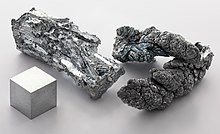 Type: Trace Element
Type: Trace Element
Periodic Element: (Zn)
RDA: ~15 mg.
Importance- To Body:
Constituent of several enzymes; as component of carbonic anhydrase, important in CO2 metabolism; required for normal growth, wound healing, taste, smell, sperm production.
Distribution- In Body:
* Approx. % of Body Mass
Concentrated in Liver, Kidneys, Brain; excreted in feces
Excess Effects:
Fever, Nausea, Vomiting, Diarrhea, Difficulty in walking; Slurred speech; Mask-like Facial Expression, Tremors
Deficiency Effects:
Growth Retardation; Impaired Cell Growth, Impaired Cell Repair, Poor Wound Healing, Learning impairment; Impaired Sense of Taste, Impaired Sense of smell, Small Reproductive Glands, Depressed Immunity
Sources Food:
Meats, Liver, Seafood, Eggs, Legumes, Milk, Green Vegetables, Cereals, Nuts, Wheat germ, Yeast
Sources Environmental/Geographic:
None listed
Supplemental Information:
 |
|||||||||||||||||||||||||||||||||||||||||||||||||||||||||||||||
| General properties | |||||||||||||||||||||||||||||||||||||||||||||||||||||||||||||||
|---|---|---|---|---|---|---|---|---|---|---|---|---|---|---|---|---|---|---|---|---|---|---|---|---|---|---|---|---|---|---|---|---|---|---|---|---|---|---|---|---|---|---|---|---|---|---|---|---|---|---|---|---|---|---|---|---|---|---|---|---|---|---|---|
| Appearance | silver-gray | ||||||||||||||||||||||||||||||||||||||||||||||||||||||||||||||
| Standard atomic weight (Ar, standard) | 65.38(2) | ||||||||||||||||||||||||||||||||||||||||||||||||||||||||||||||
| Zinc in the periodic table | |||||||||||||||||||||||||||||||||||||||||||||||||||||||||||||||
|
|||||||||||||||||||||||||||||||||||||||||||||||||||||||||||||||
| Atomic number (Z) | 30 | ||||||||||||||||||||||||||||||||||||||||||||||||||||||||||||||
| Group | group 12 | ||||||||||||||||||||||||||||||||||||||||||||||||||||||||||||||
| Period | period 4 | ||||||||||||||||||||||||||||||||||||||||||||||||||||||||||||||
| Element category | post-transition metal, alternatively considered a transition metal | ||||||||||||||||||||||||||||||||||||||||||||||||||||||||||||||
| Block | d-block | ||||||||||||||||||||||||||||||||||||||||||||||||||||||||||||||
| Electron configuration | [Ar] 3d10 4s2 | ||||||||||||||||||||||||||||||||||||||||||||||||||||||||||||||
|
Electrons per shell
|
2, 8, 18, 2 | ||||||||||||||||||||||||||||||||||||||||||||||||||||||||||||||
| Physical properties | |||||||||||||||||||||||||||||||||||||||||||||||||||||||||||||||
| Phase at STP | solid | ||||||||||||||||||||||||||||||||||||||||||||||||||||||||||||||
| Melting point | 692.68 K (419.53 °C, 787.15 °F) | ||||||||||||||||||||||||||||||||||||||||||||||||||||||||||||||
| Boiling point | 1180 K (907 °C, 1665 °F) | ||||||||||||||||||||||||||||||||||||||||||||||||||||||||||||||
| Density (near r.t.) | 7.14 g/cm3 | ||||||||||||||||||||||||||||||||||||||||||||||||||||||||||||||
| when liquid (at m.p.) | 6.57 g/cm3 | ||||||||||||||||||||||||||||||||||||||||||||||||||||||||||||||
| Heat of fusion | 7.32 kJ/mol | ||||||||||||||||||||||||||||||||||||||||||||||||||||||||||||||
| Heat of vaporization | 115 kJ/mol | ||||||||||||||||||||||||||||||||||||||||||||||||||||||||||||||
| Molar heat capacity | 25.470 J/(mol·K) | ||||||||||||||||||||||||||||||||||||||||||||||||||||||||||||||
Vapor pressure
|
|||||||||||||||||||||||||||||||||||||||||||||||||||||||||||||||
| Atomic properties | |||||||||||||||||||||||||||||||||||||||||||||||||||||||||||||||
| Oxidation states | -2, 0, +1, +2 |
||||||||||||||||||||||||||||||||||||||||||||||||||||||||||||||
| Electronegativity | Pauling scale: 1.65 | ||||||||||||||||||||||||||||||||||||||||||||||||||||||||||||||
| Ionization energies |
|
||||||||||||||||||||||||||||||||||||||||||||||||||||||||||||||
| Atomic radius | empirical: 134 pm | ||||||||||||||||||||||||||||||||||||||||||||||||||||||||||||||
| Covalent radius | 122±4 pm | ||||||||||||||||||||||||||||||||||||||||||||||||||||||||||||||
| Van der Waals radius | 139 pm | ||||||||||||||||||||||||||||||||||||||||||||||||||||||||||||||
|
|||||||||||||||||||||||||||||||||||||||||||||||||||||||||||||||
| Miscellanea | |||||||||||||||||||||||||||||||||||||||||||||||||||||||||||||||
| Crystal structure | hexagonal close-packed (hcp) | ||||||||||||||||||||||||||||||||||||||||||||||||||||||||||||||
| Speed of sound thin rod | 3850 m/s (at r.t.) (rolled) | ||||||||||||||||||||||||||||||||||||||||||||||||||||||||||||||
| Thermal expansion | 30.2 µm/(m·K) (at 25 °C) | ||||||||||||||||||||||||||||||||||||||||||||||||||||||||||||||
| Thermal conductivity | 116 W/(m·K) | ||||||||||||||||||||||||||||||||||||||||||||||||||||||||||||||
| Electrical resistivity | 59.0 nΩ·m (at 20 °C) | ||||||||||||||||||||||||||||||||||||||||||||||||||||||||||||||
| Magnetic ordering | diamagnetic | ||||||||||||||||||||||||||||||||||||||||||||||||||||||||||||||
| Magnetic susceptibility | −11.4·10−6 cm3/mol (298 K) | ||||||||||||||||||||||||||||||||||||||||||||||||||||||||||||||
| Young's modulus | 108 GPa | ||||||||||||||||||||||||||||||||||||||||||||||||||||||||||||||
| Shear modulus | 43 GPa | ||||||||||||||||||||||||||||||||||||||||||||||||||||||||||||||
| Bulk modulus | 70 GPa | ||||||||||||||||||||||||||||||||||||||||||||||||||||||||||||||
| Poisson ratio | 0.25 | ||||||||||||||||||||||||||||||||||||||||||||||||||||||||||||||
| Mohs hardness | 2.5 | ||||||||||||||||||||||||||||||||||||||||||||||||||||||||||||||
| Brinell hardness | 327–412 MPa | ||||||||||||||||||||||||||||||||||||||||||||||||||||||||||||||
| CAS Number | 7440-66-6 | ||||||||||||||||||||||||||||||||||||||||||||||||||||||||||||||
| History | |||||||||||||||||||||||||||||||||||||||||||||||||||||||||||||||
| Discovery | Indian metallurgists (before 1000 BCE) | ||||||||||||||||||||||||||||||||||||||||||||||||||||||||||||||
| First isolation | Andreas Sigismund Marggraf (1746) | ||||||||||||||||||||||||||||||||||||||||||||||||||||||||||||||
| Recognized as a unique metal by | Rasaratna Samuccaya (800) | ||||||||||||||||||||||||||||||||||||||||||||||||||||||||||||||
| Main isotopes of zinc | |||||||||||||||||||||||||||||||||||||||||||||||||||||||||||||||
|
|||||||||||||||||||||||||||||||||||||||||||||||||||||||||||||||
Zinc is a chemical element with symbol Zn and atomic number 30. It is the first element in group 12 of the periodic table. In some respects zinc is chemically similar to magnesium: both elements exhibit only one normal oxidation state (+2), and the Zn2+ and Mg2+ions are of similar size. Zinc is the 24th most abundant element in Earth's crust and has five stable isotopes. The most common zinc ore is sphalerite (zinc blende), a zinc sulfide mineral. The largest workable lodes are in Australia, Asia, and the United States. Zinc is refined by froth flotation of the ore, roasting, and final extraction using electricity (electrowinning).
Brass, an alloy of copper and zinc in various proportions, was used as early as the third millennium BC in the Aegean, Iraq, the United Arab Emirates, Kalmykia, Turkmenistan and Georgia, and the second millennium BC in West India, Uzbekistan, Iran, Syria, Iraq, and Israel (Judea). Zinc metal was not produced on a large scale until the 12th century in India, though it was known to the ancient Romans and Greeks. The mines of Rajasthan have given definite evidence of zinc production going back to the 6th century BC. To date, the oldest evidence of pure zinc comes from Zawar, in Rajasthan, as early as the 9th century AD when a distillation process was employed to make pure zinc.Alchemists burned zinc in air to form what they called "philosopher's wool" or "white snow".
The element was probably named by the alchemist Paracelsus after the German word Zinke (prong, tooth). German chemist Andreas Sigismund Marggraf is credited with discovering pure metallic zinc in 1746. Work by Luigi Galvani and Alessandro Volta uncovered the electrochemical properties of zinc by 1800. Corrosion-resistant zinc plating of iron (hot-dip galvanizing) is the major application for zinc. Other applications are in electrical batteries, small non-structural castings, and alloys such as brass. A variety of zinc compounds are commonly used, such as zinc carbonate and zinc gluconate (as dietary supplements), zinc chloride (in deodorants), zinc pyrithione (anti-dandruff shampoos), zinc sulfide (in luminescent paints), and zinc methyl or zinc diethyl in the organic laboratory.
Zinc is an essential mineral, including to prenatal and postnatal development.Zinc deficiency affects about two billion people in the developing world and is associated with many diseases. In children, deficiency causes growth retardation, delayed sexual maturation, infection susceptibility, and diarrhea.Enzymes with a zinc atom in the reactive center are widespread in biochemistry, such as alcohol dehydrogenase in humans. Consumption of excess zinc can cause ataxia, lethargy and copper deficiency.


